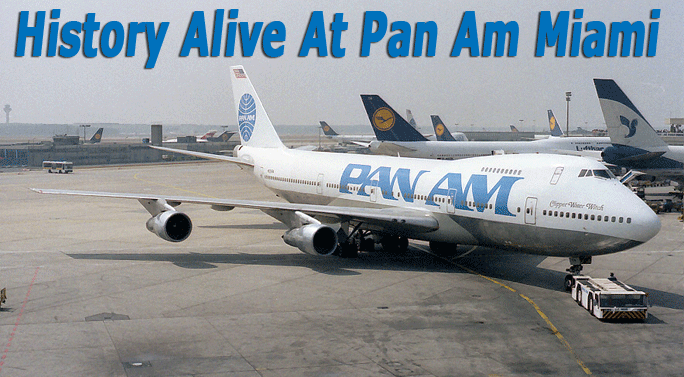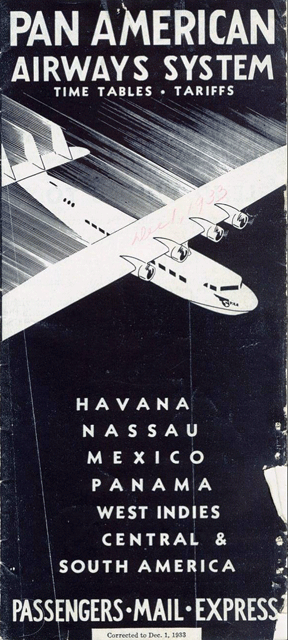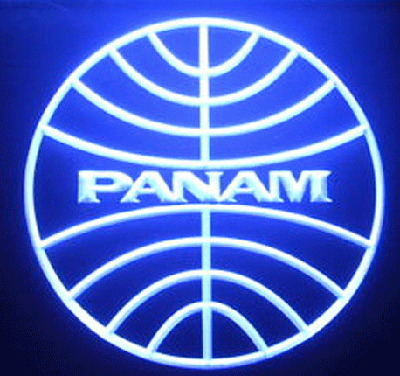
Pictured here is PAA’s “Clipper Water Witch”
at Frankfurt shortly before the end came
 In
1991 when Pan American World Airways went out of business as some last
ATR commuter type aircraft made their final flights into John F. Kennedy
International Airport in New York, many aviation people the world over
lamented what went wrong.
In
1991 when Pan American World Airways went out of business as some last
ATR commuter type aircraft made their final flights into John F. Kennedy
International Airport in New York, many aviation people the world over
lamented what went wrong.
“Too many long haul routes.”
“No real domestic feed into hubs.”
“Wrong airplanes, bad acquisitions,
management, timing,” and even just plain “bad luck,”
people said was the reason for the downfall of Pan Am.
It seems the one point almost everyone
missed was what had happened to the world’s greatest airline might
some day also visit almost every other USA flag carrier.
Today, with the exception of American
Airlines and Southwest, every major USA flag airline has either been
into or just emerged from bankruptcy, some more than once.
Right now while domestic routes are shrinking
in terms of players and even airplane size amongst the majors, routes
to overseas destinations that PAA pioneered with China Clipper, Yankee,
Anzac, Southern and other Clippers are all the rage as the eventual
savior to airlines’ bottom lines.
One city in USA—Miami, Florida owes
much of its aviation legacy and lore to Pan Am.
Fittingly most of the airline photo and
written archives are kept there at the Otto. G. Richter Library at the
University of Miami.
You can figure wherever records are kept
in some kind of orderly manner, that people will study them and draw
some conclusions.
William E. Brown, Director of Archives
at Richter has done just that after having studied PAA during the past
18 years since PAA folded.
His words come out of the mountain of
written documents and pictures in the Richter Collection.
“Pan Am helped take the world to
Miami.
“People were to set their watches
by Pam Am planes.
“Indeed Pan American World Airways
Inc., “Pan Am” to generations of employees and travelers
worldwide helped change the nature of international air travel and commerce.
“Pan Am and Miami are bound in a
historic, economic and emotional relationship.
“From its Miami, Florida base Pan
Am introduced commercial aviation to virtually every corner of the globe,
and in so doing, changed the way people viewed themselves and the world.
“Pan Am inaugurated mail and small
package cargo service between Key West and Havana Cuba on October 28,1927.
“PAA delivered mail, shipped agricultural
products and manufactured goods, and transported business commuters,
tourists and other travelers.
“Pan Am did everything with enormous
style, whether it was designing airport terminals or its own advertising
where none had been created before the airline.
“Pan Am's architectural commissions
include the Marine Air Terminal at LaGuardia Airport in New York City;
the entire original 36th Street Airport on the site of what is now MIA,
and the seaplane complex at Dinner Key, part of which serves as Miami
City Hall, that today is a treasured building and address by people
around the world.”
Mentioned at the top the ATR aircraft
that to our knowledge were the last revenue flights of Pan Am.
The aircraft that pioneered super jumbo
was a Pan Am invention, when the carrier “fronted” the development
of B747 much in the same manner Emirates of Dubai with orders for 45
A380s is doing the same for the next generation of super commercial
aircraft.
But before PAA kissed off into history
one more original idea joined a 64-year legacy of firsts.
Before PAA, nobody billboarded a logo
or airline name top to bottom on an aircraft tube, a practice that is
commonplace today.
Innovation from start to finish, and then
Pan Am fell on its sword and was no more.
Certainly in the future even more will
emerge from those Richter Library papers as the past allows those who
can see it, an opportunity to better understand what lies ahead.
We wonder for example in 2007, what made
any of us think that what happened to “The World’s Greatest
Airline” eventually would not happen to the entire American airline
industry and elsewhere to air carriers around the globe as well?
But for now we share the memories of this
homage, some taken from a book we wrote in 1986 titled “Great
Airports Miami International,” while awaiting other answers.
A Postscript:
 There still is one place that allows
the visitor to be surrounded even if just for a few moments in an atmosphere
that is all Pan Am.
There still is one place that allows
the visitor to be surrounded even if just for a few moments in an atmosphere
that is all Pan Am.
Mary Goshgarian at 82 years of age operates
The Pan Am Aware Store located in the Pan Am International Flight Academy
Building at 5000 NW 36th St., Miami, Florida ,
The place is part of Miami International
Airport’s boundaries just close to the place where Pan Am built
the entire airport in 1927 in the first place.
Goshgarian, who worked for Pan Am in The
Clipper Club for 35 years actually also operated this place while the
airline was still in business on a volunteer basis.
"We have pilots stopping in here
all the time looking for a piece of Pan Am memorabilia," Goshgarian
said.
Here you can find both original stuff
and reproductions.
The store has a selection of original
items, including Pan Am dishes, cabin silver and even onboard water
pitchers.
There also are dozens of new items.
Jeff Kriendler of Miami Beach, a board
member of the Pan Am Historical Foundation, said discussions have been
held with the Historical Foundation of Southern Florida about creating
an aviation and maritime museum, perhaps
on Watson Island.
Kriendler, who once was the chief public
relations man at Pan Am, when the carrier occupied the now Met Life
office tower at 200 Park Avenue in New York City, said something quite
touching to a reporter from a local newspaper, The Florida Sun Sentinel.
"That little store represents Pan
Am as it exists today—in the memories of thousands and thousands
of people."
The Pan Am Aware store is open weekdays from 11 a.m. to 3 p.m. Phone
number is 305-871-1028.
Geoffrey



